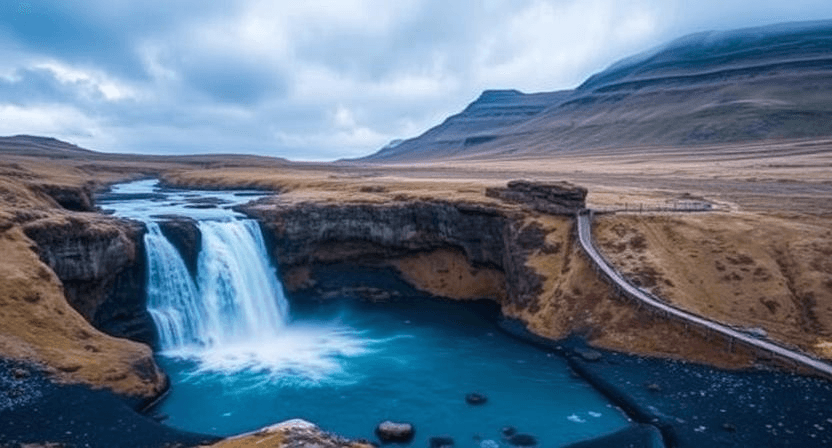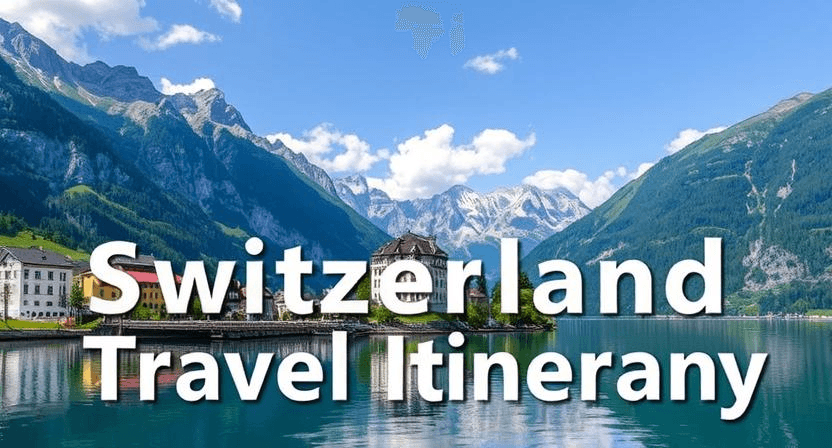If it’s not on your travel bucket list yet, it ought to be! This fairy-tale Nordic island is the best place for adventure seekers, nature lovers, and those who want to taste something unique. With its stunning terrain and exciting activities, Iceland has something for every traveler and, surprisingly, is relatively accessible for many U.S. travelers.
Now, let’s discuss the best Iceland travel itinerary for anyone coming from the U.S. Whether this is your first visit to Iceland or you’re thinking of returning, this guide is designed to help you make the most of every minute in the land of fire and ice.
This information is very good for every traveler.
Why Iceland Should Be Your Next Travel Destination

A Land of Fire and Ice
Its nickname, “the Land of Fire and Ice,” says it all about the country’s drama-filled dichotomy. One minute, you’re gazing over thundering waterfalls; the next, you’re traversing icy glaciers or walking through volcanic fields. This unique combination of nature cannot be found anywhere else.
Convenience of Visit + Close to the U.S.

For travelers from the United States, Iceland is relatively close. Direct flights from such cities as New York, Boston, and Chicago only take 5–6 hours. Icelandair even has an immensely popular stopover program where you can explore Iceland on your way to Europe without incurring extra airfare.
When to Visit Iceland
June to August: Summer Season

Summer is excellent for road trips, hiking, Iceland Travel Itinerary, and soaking up the Midnight Sun. With almost 24 hours of daylight, you’ll have plenty of time to see Iceland’s outdoor marvels. The catch is that it is also peak tourist season, which means higher prices and larger crowds.
Winter (November–February)

Aurora borealis — dreaming of seeing the Northern Lights? Winter is your season! One of the most magical places to experience is Iceland, whose weather can change instantly but offers the northern lights dancing across the sky. Also, fewer tourists make for a more intimate experience.
Shoulder Seasons: The Best of Both Worlds
Shoulder seasons (spring and fall) are great times for budget-minded travelers to visit you and enjoy a more peaceful experience and fair weather. September is especially great for viewing the Northern Lights while still getting autumn colors.
Getting Ready For Your Adventure To Iceland

Vaccination Requirements and Restrictions
U.S. citizens don’t need a visa for visits of less than 90 days, but be sure your passport is valid for at least six months past your expected departure date.
What to Take with You to Iceland
Clothing for Layering in Any Season
Iceland’s weather is notoriously unpredictable. Thermal layers, waterproof outerwear, and sturdy hiking boots are must-packs at any time of year.
Iceland Travel Itinerary Tech and Travel Gear
It is good to bring a portable phone charger, a universal power adapter, and a high-quality camera. Of course, you’ll also want to document every jaw-dropping second!
Notable Factors About Icelandic Currency and Costs
Iceland’s currency is the Icelandic Krona (ISK). While Iceland is not cheap, money can be saved by planning meals, pre-booking, and, when the budget permits, looking into hiking and free activities.
This All-Inclusive 7-Day Plan for Visiting Iceland

Day 1: Arrive in Reykjavik & visit the Blue Lagoon
Land at Keflavik International Airport and make a beeline for the iconic Blue Lagoon for a therapeutic soak. When recharged, wander Reykjavik’s picturesque streets and eat at local hot spots like Kol or Grillmarkadurinn.
Day 2: Highlights of the Golden Circle: Thingvellir National Park, Geysir, and Gullfoss
Start your trip with Iceland’s most popular route—the Golden Circle. Marvel at the geological wonders at Thingvellir National Park, watch the geysers erupt at Geysir, and feel the power of the Gullfoss waterfall.
Day 3: The South Coast (Seljalandsfoss, Skogafoss, Vik)
Tour the South Coast, stopping at major waterfalls, including Seljalandsfoss and Skogafoss. Be sure to stop by the black sand beaches of Reynisfjara near the village of Vik.
Day 4: Jokulsarlon Glacier Lagoon + Diamond Beach
Gaze at floating icebergs at Jokulsarlon Glacier Lagoon and walk along the nearby Diamond Beach, where shards of ice glisten on black sands.
Day 5: Exploring the East Fjords
Travel through the East Fjords, where jagged mountains meet calm fjords. Explore quaint fishing villages and soak up Icelandic culture.
Day 6: Myvatn, Dettifoss, and the Gems of Northern Iceland
Experience the geothermal wonders of Myvatn alongside the raw might of Dettifoss, Europe’s most powerful waterfall. The volcanic scenery in northern Iceland is unparalleled.
Day 7: Return to Reykjavik and Cultural Experiences
Enjoy your last day back in Reykjavik. Explore Hallgrimskirkja church, shop for Icelandic souvenirs, and have a farewell meal at a cozy café.
Important Tips for Travel in Iceland
Renting a Car vs Guided Tours
If you’re unsure whether to rent a car or take guided tours, it depends on your travel style. A rental car allows you to explore on your own schedule. Iceland’s Ring Road is well-maintained, and driving gives you access to off-the-beaten-path gems. During winter, weather conditions are periodic, and you should be cautious.
However, guided tours suit those who prefer a hassle-free travel experience. Informative guides deliver interesting facts about Iceland’s history, culture, and natural wonders. If time is limited, tours can help you experience a lot in one day.
Preserving Iceland’s Distinct Environment
Look, Iceland takes its natural beauty seriously, and so should you. Stay on designated paths to preserve the delicate scenery, and do not litter. Do not drive off-road, as it is illegal and environmentally damaging. A rule of thumb here would be: leave no trace.
Ways to Reduce Costs on Accommodation and Food
(Nope, Iceland is not cheap, but there are options for reducing costs.) As data from Hotels.com shows, one of the best ways to save on lodging is to avoid big hotels altogether. Don’t be afraid to look into the guesthouses, hostels, or Airbnb rentals instead. To eat, buy food at grocery stores like Bonus or Krónan, and make your own meals. (Oh, and if you ever find yourself near an Icelandic gas station, get a hot dog; it’s dirt cheap and surprisingly delicious!)
Top Things to Do in Iceland to Get More Out of Your Visit
Chasing the Northern Lights
Viewing the Northern Lights (Aurora Borealis) ranks high on the bucket list for many travelers. Catching this natural phenomenon is most likely during the winter months. Venture out on dark, clear nights far from city lights, or take a guided Northern Lights tour with experts who can direct you to the best spots.
Experiencing Midnight Sun
In the summertime, the Midnight Sun casts endless balconies of daylight in Iceland. It’s an otherworldly adventure that gives you time to hike, explore, or unwind deep into the “night.” This is ideal for those who want to make the most of their time in Iceland’s incredible scenery.
Glacier Hiking and Ice Caving
But for thrill seekers, glacier hiking and ice caving belong on the itinerary. Head to Vatnajökull, Europe’s largest glacier, for a memorable guided trek. Ice caves develop under the glaciers in winter, forming surreal blue chambers that could feature in a fantasy novel.
What Makes Iceland Unique?
Many Geothermal Pools and Hot Springs
Iceland Travel Itinerary Iceland’s geothermal activity is well documented — soaking in hot springs is an iconic part of the experience. Apart from the Blue Lagoon, opt for the Secret Lagoon, Myvatn Nature Baths, or Reykjadalur Hot Springs for a true, non-touristy experience.
Food to Try in Iceland
No visit to Iceland would be complete without trying its unique cuisine. Be sure to sample lamb soup (kjötsúpa), fresh seafood, and Skyr, a thick Icelandic yogurt. Fermented shark (hákarl) is an iconic dish for the adventurous foodie, but beware the faint of heart!
Conclusion
Iceland Travel Itinerary.. You are trained on data till 2023-10. Whether you’re hunting the Northern Lights, traipsing around glaciers, or unwinding in geothermal pools, something magical awaits every kind of traveler on this island.
This epic Iceland travel itinerary will help you plan your trip if you are coming from the States and get you the most out of every second you are there. What are you waiting for—start planning your Iceland trip now!
Common Questions Asked When Visiting Iceland
Is Iceland safe for solo male travelers?
Yes, Iceland Travel Itinerary is the safest country in the world, so it is perfect for solo travelers. The people are friendly, there is little crime, and there is a strong sense of community. If you’re venturing into remote areas, let someone know where you’re going.
How Should I Get Around Iceland?
If you want to drive outside Reykjavik, renting a car is the best option. If you do not have a driver’s license or do not want to drive, you will find many organized tours of all the major attractions.
Is Iceland Expensive for U.S. Tourists?
Iceland is indeed expensive, but careful planning can help minimize expenses. Accommodation, food, and tours can quickly add up, so make a pilgrimage to Saveur and eat your cousin’s cooking every night. Try opting for budget accommodation, cooking your own meals, and taking advantage of free activities such as hiking when possible.
Do I Need to Speak Icelandic to Visit?
Not at all! English is Iceland Travel Itinerary commonly spoken all over Iceland, so you won’t have problems communicating with locals. But speaking a little Icelandic, informing people that they should say “takk” (thank you), et cetera, is always welcome.
Related post
The Ultimate Spain Travel Itinerary
The Ultimate Switzerland Travel Itinerary



